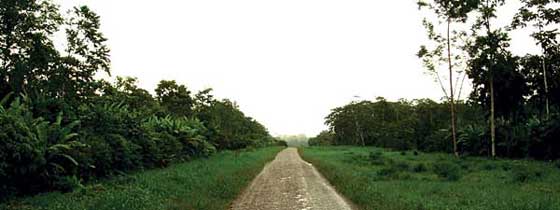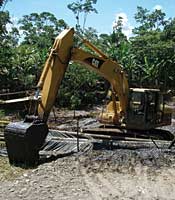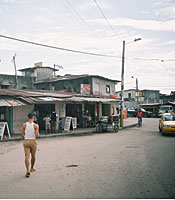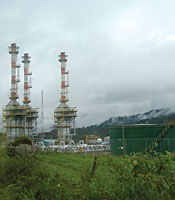Pink Floyd was playing on the loudspeaker of the ferry transporting us over the Rio Napo into the 2,700-square-mile Yasuni National Park in the Amazon basin in Ecuador’s El Oriente region. We had missed the previous ferry after making hours of slow progress over rutted roads through a largely denuded countryside, then had to kill an hour in a shoreside scene of extreme informality—hot sun, muddy, littered paths along the river, lazing dogs, scattered houses, a little shop, and a dirt parking lot for waiting vehicles. The scene on the other side, however, was more like Guantanamo. From the dock, my students from City College and I walked along narrow chain-link passages topped with razor wire, passed though a magnetometer, had hand luggage X-rayed and passports balefully compared to a list sent in advance, and watched our bus be taken into a camouflage-painted metal shed for the once-over. No Coke stands or pleasantries here. Instead, there were gun towers, searchlights, signs forbidding alcohol and drugs, and M-16-toting men from the Ecuadorian army and private security firms with Orwellian names like Servisafe and Servipro. An unexpected gateway to paradise.
Yasuni is one of the most biodiverse areas on the planet—a UNESCO “world biosphere reserve”—a river-laced rain forest teeming with life and home to the indigenous Haorani people. And to oil. Crossing the river, we were entering Block 16, one of the giant concessions that have platted Oriente since 1967, when a consortium of Texaco and Gulf discovered huge oil reserves there. By mid-1972, exploitation was in full swing and a 312-mile-long pipeline had been constructed from the now-booming village of Neuva Loja (universally called Lago Agrio—Bitter Lake—after Texaco’s headquarters in Texas) to the coast from which the crude is shipped abroad, primarily to the U.S. The high security was intended to protect this resource, to secure the jungle against incursions by terrorists, smugglers, narcotics traffickers, poachers, loggers, and settlers. Of course, it did nothing to protect the area from the traumatic impact of petroleum itself.
| |||||||
The effects of oil on the Ecuadorian landscape have been profound. On the one hand, oil has fueled a boom economy which, especially in the go-go 1970s and ’80s, generated much middle- and upper-class prosperity and government investment in public infrastructure. On the other, oil has been an environmental disaster, say people living in the area. Thousands of square miles of rain forest have disappeared. The lives of numerous indigenous peoples have been forever disrupted. And vast areas have become toxic. According to a class-action lawsuit filed in 2003 against the oil companies by 30,000 settlers and people indigenous to the Amazon, Texaco and its successor, Chevron, have not just spilled oil in the jungle (more than what leaked from the Exxon Valdez), but also dumped billions of gallons of toxic wastewater. Much of the oil is extracted via the injection of water under high pressure, and rather than following the standard practice of deep re-injection of wastes, the company simply dumped it in ground-level pits, says Judith Kimmerling in her book Amazon Crude (1990). Plaintiffs in the lawsuit claim these practices have had severe consequences on the health of people living in the area. The lawsuit, which attempts to recover the cost of the estimated $6 billion cleanup, continues to work its way at a snail’s pace through the courts, as does an Ecuadorian government suit claiming fraud on Chevron’s part.
The oil concessions—covering thousands of square miles—have a very specific spatiality, a format that is, by stages, turning the forest not simply into a degraded, toxic environment but into an urbanism, a city of a new “disarticulated” character that combines webs and nodes, formality and informality, density and dispersion. Its components include grids of seismic trails (10-foot-wide pathways in which a 6.5-to-16-foot-deep hole is dug every 328 feet to hold 22-to-44 pounds of dynamite for acoustic exploration), networks of wells and toxic dumps, pumping stations, refineries, tank farms, pipelines, helicopter landing zones, airports, roadways, security check-points, military installations, and a proliferation of camps, depots, towns, and villages. In an environmental lawsuit filed against Atlantic Richfield in 1993, the plaintiffs inventoried—in this one concession—339 wells, 18,000 miles of seismic trails, 300 miles of roads, 600 toxic-waste pits, and 1,368 helicopter landing sites. Welcome to Petropolis.







Post a comment to this article
Report Abusive Comment